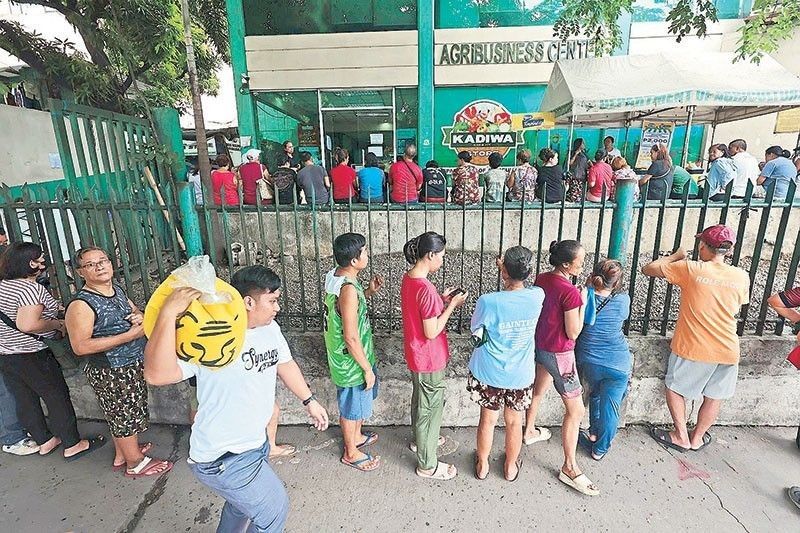Farmers seek TRO vs rice tariff cut

MANILA, Philippines — Farmers’ groups yesterday asked the Supreme Court to issue a temporary restraining order (TRO) against Executive Order No. 62 allowing a reduced tariff of 15 percent on imported rice, as they asked that the order be declared null and void and unconstitutional.
The 26-page petition was filed by the Samahang Industriya ng Agrikultura, Federation of Free Farmers, United Broiler Raisers Association, Sorosoro Ibaba Development Cooperative and Magsasaka party-list president Argel Joseph Cabatbat.
Named respondents were President Marcos, Executive Lucas Bersamin, National Economic and Development Secretary (NEDA) Secretary Arsenio Balisacan and Tariff Commission Chairperson Marilou Mendoza.
The petitioners noted that farmers were “shocked” Bersamin signed EO 62, also known as “Modifying the Nomenclature and rates of Import Duty on Various Products” on June 20.
The petitioners said that they were never informed nor were they ever called for investigation about the reduction of rice tariff.
According to the petitioners, EO 62 was hastily issued sans the consultation, investigation, hearings and reports, which are required by the Flexible Clause of Customs Modernization and Tariff Act or Republic Act 10863 to be complied with before the President can validly make issuance of an executive order involving tariff reduction.
“It is well to emphasize that included in the reduced tariff is rice – the most staple food of the Filipino people. Also reduced are the tariff of corn, pork and chicken meat. Prior to issuance of EO 62, tariffs for corn imports was already lowered to five percent; 15 percent tariffs for pork; and 35 percent tariffs for rice imports under EO 10,” the petition added.
They added that lowering tariffs on products, specifically staple foods like rice and corn, poses significant challenges for local farmers. Lower tariffs can lead to an influx of cheaper imported goods, undermining domestic producers’ and farmers’ sales and products.
In a statement, Balisacan said NEDA respects the legal process and will respond to the petition filed by farmers’ groups in due course.
Meanwhile, the Department of Agriculture (DA) and NEDA will form a technical working group (TWG) that would focus on reviewing rice tariffs and determine the need to modify the rates.
The TWG would also involve rice industry stakeholders including groups like FFF and SINAG, Agriculture Undersecretary Christopher Morales said.
NEDA Undersecretary Rosemarie Edillon said the first order of business of the TWG is to form a review framework that would involve the establishment of “triggers” that would determine whether to raise the 15 percent rice tariffs or not.
In effect, Edillon said the government is implementing a flexible or variable tariff scheme because of the possibility of adjusting rice tariffs after each mandated review.
Tariff Commission commissioner Marissa Paderon said the tariff rates stipulated under EO 62 can be modified through Section 1608 or the Flexible Clause of the Customs Tariff and Modernization Act.
Earlier, Agriculture Secretary Francisco Tiu Laurel Jr. said the rice tariffs should be raised once prevailing retail rice prices fall between P42 and P45 per kilogram.
The mandatory review is set in November, coinciding with the peaking of the country’s main palay harvest season.
P29/K rice sold today at Kadiwa
The Department of Agriculture (DA) would start selling rice at P29 per kilogram today in 10 Kadiwa sites in Metro Manila, benefitting about 60,000 households in the vulnerable sectors during the first month of its large-scale trial.
The program, now known as Program 29 or P29, marks the large-scale trial of the government’s sale of subsidized rice to Pantawid Pamilyang Pilipino Program beneficiaries, persons with disabilities, solo parents and senior citizens.
The identified sites are Bureau of Plant Industry compound in Manila, Bureau of Animal Industry and National Irrigation Administration in Quezon City, Food Terminal Inc. in Taguig, Philippine Fiber Industry Development Authority in Las Piñas, Barangay 167 in Caloocan, Brgy. Fortune and BFCT in Marikina, Disiplina Village in Valenzuela and Brgy. Minuyan proper in San Jose del Monte, Bulacan.
For the start of the large-scale trials, the DA would be selling 15,000 kilograms of rice per week at each site, benefitting around 1,500 households.
On a monthly basis, each site would have 60,000 kilograms of rice stocks good for 6,000 households.
The initial stocks to be sold under the 29 Program would be the aging supplies of the National Food Authority (NFA), which are three months and older, but remain fit for human consumption.
At present, the DA has around 10,000 metric tons (MT) of rice stocks from the NFA, guaranteeing the sustainability of the program in the coming months.
The P29 program would also be rolled out soon in Visayas and Mindanao. The department targets to double the total number of Kadiwa sites selling P29 per kilogram rice by August.
Agriculture officials maintained that the P29 program is not a band-aid solution but would be a “long-term” and “sustainable” program of the government that would last until the end of the Marcos administration.
“We appeal to beneficiaries not to take advantage of this program by reselling the P29 rice from Kadiwa centers. We want to ensure that the largest number of those in the vulnerable sectors will benefit from this program,” Tiu Laurel said.
Agriculture Assistant Secretary and spokesman Arnel de Mesa assured the public that the stocks of the NFA intended for calamity relief will not be affected by the P29 program.
The DA earlier estimated that it would need 69,000 MT of rice every month to cover the 6.9 million target households of P29 program nationwide.
Rice import
The Philippines’ rice imports could reach at least five million MT by 2033 as it is expected to continue relying on foreign supplies to meet its growing demand of the staple, according to the United Nations’ Food and Agriculture Organization (FAO) and the Organization for Economic Cooperation and Development (OECD).
The OECD-FAO estimated that the Philippines would be the largest rice importer by 2033, accounting for eight percent of the 65.682 million MT projected total global rice imports that year.
By that time, the country would overtake China as the biggest buyer of rice in the world market, according to the international bodies.
“Currently, the Philippines is the second largest importer of rice. The largest importer is China where demand for rice is stabilizing due to declining population,” OECD senior agricultural policy analyst Hubertus Gay told The STAR.
The Philippines imported an average of 3.897 million MT of rice from 2021-2023 while China’s average imports stood at 5.043 million MT, based on OECD-FAO data.
China’s rice imports by 2033 would fall to 4.129 million MT, the OECD-FAO projected. – Jasper Emmanuel Arcalas, Daphne Galvez, Louise Maureen Simeon
- Latest
- Trending
































